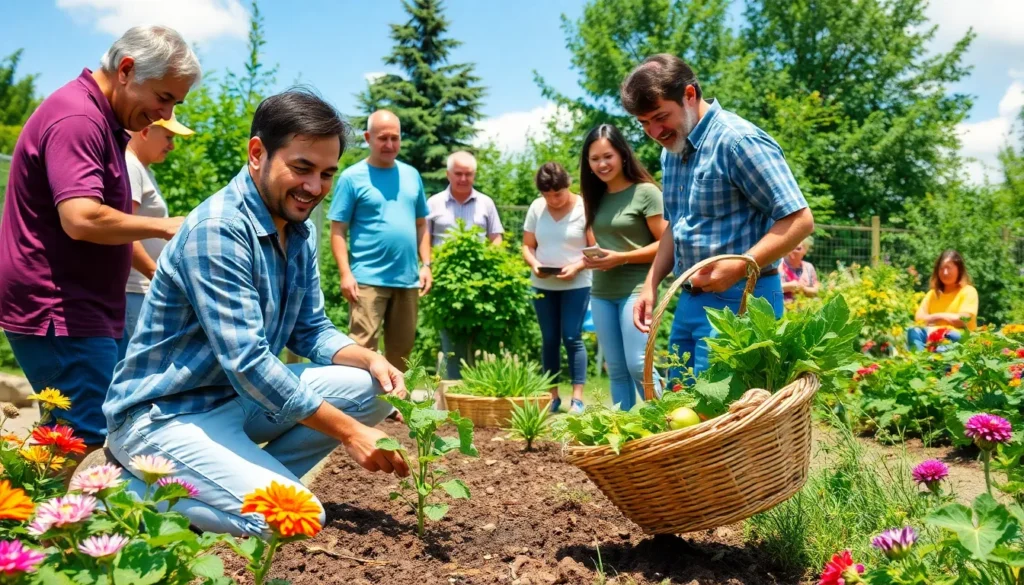Sustainable living isn’t just a trendy buzzword; it’s a lifestyle choice that can change the world—one reusable shopping bag at a time. Imagine a planet where fresh air isn’t a luxury and clean water flows like a fountain of youth. Sounds dreamy, right? Well, it’s possible, and it starts with simple changes in daily habits.
Table of Contents
ToggleWhat Impact Does Sustainable Living Have
Sustainable living promotes reduced carbon footprints, contributing to climate change mitigation. Increased use of renewable energy sources, such as solar and wind power, leads to decreased reliance on fossil fuels. Clean air and water improve public health, lowering respiratory and cardiovascular diseases.
Efficient resource management encourages biodiversity preservation. Protecting wildlife habitats allows for balanced ecosystems. Sustainable agriculture practices yield healthier crops while minimizing environmental degradation. Notably, sustainable living reduces waste through the three Rs: reduce, reuse, and recycle.
Communities that adopt sustainable practices often experience enhanced economic benefits. Local economies thrive through support for sustainable businesses and green jobs. By investing in eco-friendly technologies, societies foster innovation, leading to smarter resource utilization.
Educated consumers drive demand for ethical products, reflecting a shift in purchasing behavior. Increased awareness of environmental issues prompts individuals to make conscious choices. Sustainable living creates a ripple effect, inspiring others to adopt environmentally friendly habits.
Social equity and justice are integral to sustainability. Inclusive practices help marginalized communities access resources and opportunities. Promoting sustainability ensures that future generations inherit a healthier planet and equitable conditions.
Overall, the impact of sustainable living extends beyond individual actions, shaping a collective future that prioritizes environmental stewardship and social responsibility.
Environmental Benefits


Sustainable living greatly influences the environment, yielding significant benefits for the planet. Through small but impactful changes in lifestyle, individuals contribute to a healthier ecosystem.
Reduction in Carbon Footprint
A reduced carbon footprint plays a crucial role in combating climate change. People who adopt sustainable practices often choose renewable energy sources like solar and wind, which decrease reliance on fossil fuels. Improved transportation options, including biking and public transport, further support this reduction. Energy-efficient appliances also contribute to lower emissions, leading to cleaner air. Communities that embrace these lifestyle choices witness substantial improvements in public health, with reduced cases of respiratory illnesses.
Preservation of Natural Resources
Preserving natural resources remains vital for environmental sustainability. By practicing sustainable living, individuals actively participate in efficient resource management, which conserves water, soil, and forests. Sustainable agricultural practices yield healthier crops while minimizing pesticide use, benefiting both ecosystems and food security. Individuals engaging in recycling and composting help divert waste from landfills, ensuring resources remain in circulation longer. Conservation efforts rejuvenate habitats, allowing biodiversity to flourish, which is essential for maintaining ecological balance.
Economic Advantages
Sustainable living offers significant economic advantages that benefit individuals and communities alike. These benefits often manifest through cost savings and job creation in emerging green industries.
Cost Savings in the Long Run
Cost savings emerge from investments in energy efficiency and renewable resources. Homeowners realize reduced energy bills by utilizing solar panels and energy-efficient appliances. Long-lasting products reduce the need for frequent replacements, hence saving money over time. In addition, adopting sustainable practices like composting and water conservation can lower utility expenses. Collective savings from these environmentally friendly choices contribute to more substantial financial benefits for families and communities.
Job Creation in Green Industries
Job creation occurs as demand for sustainable products and services increases. Green industries, such as renewable energy and sustainable agriculture, experience rapid growth. Electric vehicle manufacturing has surged, leading to numerous job openings. Local economies benefit from an influx of green jobs that often pay competitive wages. Employment opportunities in these sectors strengthen community resilience and promote sustainable economic development. Investing in green initiatives ensures a stable future for workers and reinforces the commitment to sustainability.
Social Impacts
Sustainable living significantly influences social dynamics and community structures. Positive social transformations arise from environmentally-conscious choices.
Improved Public Health
Sustainable practices contribute directly to enhanced public health. Reduced air pollution leads to lower instances of respiratory ailments and cardiovascular diseases. Healthier food systems, characterized by organic farming, encourage better nutrition and food security. Increased access to green spaces provides recreational opportunities that promote physical and mental well-being. Communities supporting local food initiatives foster both social connections and healthier diets. When individuals choose sustainable transportation, they reduce traffic congestion, leading to fewer accidents and improved overall safety.
Community Engagement and Awareness
Sustainable living encourages stronger community engagement. Individuals participating in local sustainability initiatives create bonds and foster collaboration. Awareness campaigns on recycling and conservation unite households around shared goals. Workshops and community gardens act as educational platforms, teaching sustainable practices while building social ties. Events celebrating local biodiversity raise consciousness about environmental issues, prompting community action. By prioritizing sustainable living, neighborhoods can enhance resilience and cultivate a sense of community ownership and responsibility.
Challenges to Sustainable Living
Sustainable living faces several challenges that can hinder its widespread adoption. Addressing these challenges is crucial for making significant strides towards a more sustainable future.
Initial Cost Barriers
Investment costs can deter individuals and businesses from adopting sustainable practices. For instance, solar panels may require substantial upfront expenses, even though they offer long-term savings on energy bills. Energy-efficient appliances often come with a higher price tag compared to traditional models, creating hesitation among consumers. Access to financial incentives can facilitate the transition, yet many remain unaware of available programs. Overcoming these cost barriers is key to promoting sustainable choices and making them accessible for all.
Resistance to Change
Change often meets resistance, even when the benefits of sustainable living are clear. Traditional habits and lifestyles ingrained over time can be difficult to alter. People may feel overwhelmed by the perceived effort involved in making sustainable choices, which can lead to inertia. Education plays a vital role in addressing misconceptions and highlighting the advantages of sustainable practices. Engaging communities through workshops and local initiatives helps foster open-mindedness. Shifting perspectives on sustainability is essential for encouraging adaptation and promoting collective action.






